Dundee, Scotland, UK 作者: 来源: 发布时间:2021-07-29
I. Population and Area
Continent: Europe
Country: The U.K
State/Province: Scotland
City/Town: Dundee
Total Area: 23.17 (sq mi)
Population in 2016: 148.3(thousand)
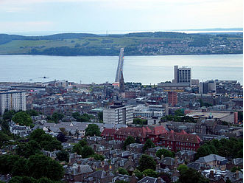
II. Natural Geography (environment and resources)
Geology
The city lies within the Sidlaw-Ochil anticline, and the predominant bedrock type is Old Red Sandstone of the Arbuthnott-Garvock group. Differential weathering of a series of igneous intrusions has yielded a number of prominent hills in the landscape, most notably the Dundee Law (a late Silurian/early Devonian Mafic rock intrusion) and Balgay hill (a Felsic rock intrusion of similar age).In the east of the city, in Craigie and Broughty Ferry, the bedrock geology is of extrusive rocks, including mafic lava and tuff.
The land surrounding Dundee, particularly that in the lower lying areas to the west and east of the city, bears high quality soil that is particularly suitable for arable farming. It is predominantly of a brown forest soil type with some gleying, the lower parts being formed from raised beach sands and gravels derived from Old Red Sandstone and lavas.
Urban environment
Very little of pre-Reformation Dundee remains, the destruction suffered in the War of the Rough Wooing being almost total, with only scattered, roofless shells remaining. The area occupied by the medieval burgh of Dundee extends between East Port and West Port, which formerly held the gates to the walled city. The shoreline has been altered considerably since the early 19th century through development of the harbour area and land reclamation. Several areas on the periphery of the burgh saw industrial development with the building of textile mills from the end of the 18th century. Their placement was dictated by the need for a water supply for the modern steam powered machinery, and areas around the Lochee Burn (Lochee), Scouring Burn (Blackness) and Dens Burn (Dens Road area) saw particular concentrations of mills. The post war period saw expansion of industry to estates along the Kingsway.
Working class housing spread rapidly and without control throughout the Victorian era, particularly in the Hawkhill, Blackness Road, Dens Road and Hilltown areas. Despite the comparative wealth of Victorian Dundee as a whole, living standards for the working classes were very poor. A general lack of town planning coupled with the influx of labour during the expansion of the jute industry resulted in insanitary, squalid and cramped housing for much of the population. While gradual improvements and slum clearance began in the late 19th century, the building of the groundbreaking Logie housing estate marked the beginning of Dundee's expansion through the building of planned housing estates, under the vision of city architect James Thomson, whose legacy also includes the housing estate of Craigiebank and the beginnings of an improved transport infrastructure by planning the Kingsway bypass.
Road
Dundee is served by the A90 road which connects the city to the M90 and Perth in the west, and Forfar and Aberdeen in the north. The part of the road that is in the city is a dual carriageway and forms the city's main bypass on its north side, known as the Kingsway. East of the A90's Forfar Road junction, the Kingsway East continues as the A972, and meets the A92 at the Scott Fyffe roundabout. Travelling east, the A92 connects the city to Arbroath and Montrose and to the south with Fife via the Tay Road Bridge.
Rail
There are other nearby stations at Invergowrie, Balmossie and Monifieth. Passenger services at Dundee are provided by Abellio ScotRail, CrossCountry, Caledonian Sleeper and London North Eastern Railway. No freight trains serve the city since the Freightliner terminal in Dundee was closed in the 1980s. There are also many intercity bus services offered by Megabus, Citylink and National Express.
Airport
Dundee Airport offers commercial flights to London City Airport and Belfast City by Scotland's Airline - Loganair .The airport is capable of serving small aircraft and is located 3 kilometres (1.9 mi) west of the city centre, adjacent to the River Tay. The cargo port of Dundee is one of the largest economic generators in the city and is operated by Forth Ports. Seafarers arriving at the port are offered welfare and pastoral assistance by seafarers charity Apostleship of the Sea.
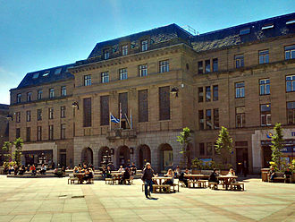
III. Economy
Dundee is a regional employment and education centre, with around 325,000 people within 30 minutes' drive of the city centre and 860,000 people within one hour. Many people from North East Fife, Angus and Perth and Kinross commute to the city. As of 2015, there were 395 employers who employed 250 or more staff; over a five-year period (2011–2015) the number of registered enterprises in Dundee increased by 20.9% from 2,655 to 3,210. The largest employers in the city are NHS Tayside, Dundee City Council, University of Dundee, Tayside Contracts, Tesco, D. C. Thomson & Co and BT.
Other employers include limited and private companies such as NCR, Michelin, Alliance Trust, Aviva, Royal Bank of Scotland, Asda, Stagecoach Strathtay, Tokheim, Scottish Citylink, Rochen Limited, C J Lang & Son (SPAR Scotland), Joinery and Timber Creations, HBOS, Debenhams, Xplore Dundee, and W. L. Gore and Associates. Between 2009 and 2014 the hardest-hit sectors, in terms of jobs, were Information and Communication, Construction and Manufacturing which each lost around 500 full-time jobs. By contrast, the Professional, Scientific and Technical sector saw an upsurge in jobs in addition to the Business Administration and Support Service sector which increased by approximately 1,000 full-time and 300 part-time jobs in the same six-year period. Gross median weekly earnings of full-time employees in Dundee in 2015 was £523.50; men received £563.40 and women £451.80. Gross weekly pay for all employees in Dundee has increased from £325.00 in 2000 to £380.00 in 2015.
The biomedical and biotechnology sectors, including start-up biomedical companies arising from university research, employ just under 1,000 people directly and nearly 2,000 indirectly. Information technology and video game development have been important industries in the city for more than 20 years. Rockstar North, developer of Lemmings and the Grand Theft Auto series was founded in Dundee as DMA Design by David Jones; an undergraduate of the Abertay University. Other game development studios in Dundee include Denki, Ruffian Games, Dynamo Games, 4J Studios and Outplay Entertainment, among others.
Dundee is also a key retail destination for North East Scotland and has been ranked 4th in Retail Rankings in Scotland. The city centre offers a wide variety of retailers, department stores and independent/specialist stores. The Murraygate and High Street forms the main pedestrian area and is home to a number of main anchors such as Marks and Spencer, Accessorise and Zara.The main pedestrian area also connects the two large shopping centres; the 420,000-square-foot (39,000-square-metre) Overgate Centre which is anchored by Debenhams, H&M, Next, Argos, and The Perfume Shop and the 310,000-square-foot (29,000-square-metre) Wellgate Centre by Home Bargains, T. J. Hughes, B&M, Superdrug, Iceland, Holland & Barrett, Poundland, Savers, The Works, Hydro Electric, Bright house,Other retail areas in the city include Gallagher Retail Park, Kingsway East Retail Park and Kingsway West Retail Park.
IV. Industrial Characterisitics
Major industries:
The period following World War II was notable for the transformation of the city's economy. While jute still employed one-fifth of the working population, new industries were attracted and encouraged. NCR Corporation selected Dundee as the base of operations for the UK in late 1945, primarily because of the lack of damage the city had sustained in the war, good transport links and high productivity from long hours of sunshine. Production started in the year before the official opening of the plant on 11 June 1947. A fortnight after the 10th anniversary of the plant the 250,000th cash register was produced.
By the 1960s, NCR had become the principal employer of the city producing cash registers, and later ATMs, at several of its Dundee plants. The firm developed magnetic-strip readers for cash registers and produced early computers. Astral, a Dundee-based firm that manufactured and sold refrigerators and spin dryers was merged into Morphy Richards and rapidly expanded to employ over 1,000 people. The development in Dundee of a Michelin tyre-production facility helped to absorb the unemployment caused by the decline of the jute industry, particularly with the abolition of the jute control by the Board of Trade on 30 April 1969.
Employment in Dundee changed dramatically during the 1980s with the loss of nearly 10,000 manufacturing jobs due to closure of the shipyards, cessation of carpet manufacturing and the disappearance of the jute trade. To combat growing unemployment and declining economic conditions, Dundee was declared an Enterprise Zone in January 1984. In 1983, the first Sinclair ZX Spectrum home computers were produced in Dundee by Timex. In the same year the company broke production records, despite a sit-in by workers protesting against job cuts and plans to demolish one of the factory buildings to make way for a supermarket. Timex closed its Dundee plant in 1993 following an acrimonious six-month industrial dispute. The Michelin Tyre factory closed in June 2020, with the loss of 850 jobs.
Major projects and related introductions:
Eden working on feasibility study for new project in Dundee, Scotland
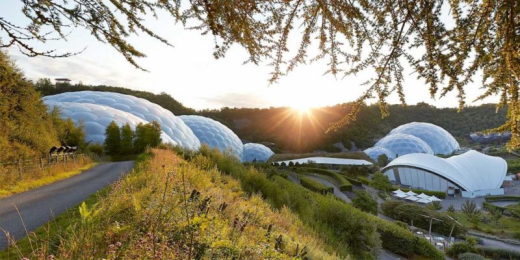
Eden is collaborating with Dundee City Council and the University of Dundee on the study, which is supported by local businesses and institutions, and is due to start in June. “We are really excited to be working in Dundee,” said David Harland, chief executive of Eden Project International. “It is a vibrant city with big ambitions and we hope to be able to create something that encapsulates its unique appeal. “The opening of the city’s V&A in 2018 was a bold statement of intent and we want to be part of the next wave, helping establish Dundee as a truly world-class destination.”
Reference Website:
https://blooloop.com/news/eden-project-scotland-dundee/
V. Attractions
1. The Tay Rail Bridge:
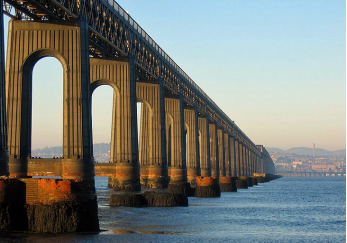
If you enter Dundee by train, you'll cross the famous iron bridge over the River Tay. The original two-mile span was built between 1872 and 1878 and carried the railroad from here to Edinburgh along what was at the time the longest bridge in the world. However, this bridge collapsed in 1879 after a storm, causing a major disaster that saw a train plunge into the frigid waters below, drowning 75 passengers in the process (stumps from this original bridge are still visible).
Completed in 1887 as a replacement for its predecessor, the present bridge took nine years to build (using recovered girders from the original) and remains one of the worlds' most spectacular railway journeys. Two viewing platforms are located on the bridge affording fine views over Dundee and the Firth of Tay. The nearby (and much newer, opening in 1964) Forth Road Bridge is great for those walking or cycling around the city and offers a number of viewing platforms with superb views over its older neighbor.
2. Discovery Point and the RRS Discovery:
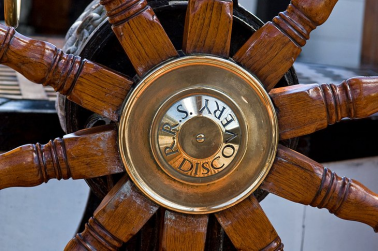
Located on the Dundee waterfront, Discovery Point documents the history of the royal research ship RRS Discovery and also vividly illustrates the natural wilderness and awe-inspiring beauty of the Polar Regions through state-of-the-art special effects and audio-visual presentations. Visitors can also climb over the vessel, built in Dundee to take Robert F. Scott on his expedition to the Antarctic between 1901 and 1904. The vessel is notable as the last wood-built, three-masted vessel to be constructed in Britain, and at the time boasted the strongest wooden hull of any ship in history. This top-rated Dundee tourist attraction also has a cafe and shop to enjoy.
3. V&A Dundee:
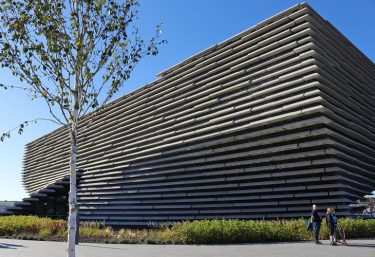
One of the newest major attractions to open in Scotland, the V&A Dundee was unveiled in all its hi-tech glory in the fall of 2018. Boasting a stunning design meant to resemble the cliffs of east Scotland — though it definitely sports the profile of a galleon (or even a whale) from one angle — this splendid new museum is the first in the country to be dedicated solely to achievements and trends of Scottish design.
Reference Website:
https://www.planetware.com/tourist-attractions-/dundee-sco-tays-dundee.htm
VI. History
The name "Dundee" is made up of two parts: the common Celtic place-name element dun, meaning fort; and a second part that may derive from a Celtic element, cognate with the Gaelic dè, meaning 'fire'.
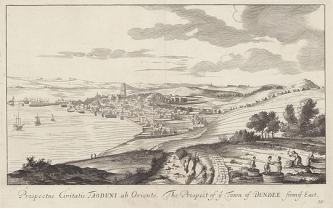
While earlier evidence for human occupation is abundant, Dundee's success and growth as a seaport town arguably came as a result of William the Lion's charter, granting Dundee to his younger brother, David (later Earl of Huntingdon) in the late 12th century. The situation of the town and its promotion by Earl David as a trading centre led to a period of prosperity and growth. The earldom was passed down to David's descendants, amongst whom was John Balliol. The town became a Royal Burgh on John's coronation as king in 1292. The town and its castle were occupied by English forces for several years during the First War of Independence and recaptured by Robert the Bruce in early 1312. The original Burghal charters were lost during the occupation and subsequently renewed by Bruce in 1327.
The burgh suffered considerably during the conflict known as the Rough Wooing of 1543 to 1550, and was occupied by the English forces of Andrew Dudley from 1547. In 1548, unable to defend the town against an advancing Scottish force, Dudley ordered that the town be burnt to the ground.In 1645, during the Wars of the Three Kingdoms, Dundee was again besieged, this time by the Royalist Marquess of Montrose.The town was finally destroyed by Parliamentarian forces led by George Monck in 1651.The town played a pivotal role in the establishment of the Jacobite cause when John Graham of Claverhouse, 1st Viscount Dundee raised the Stuart standard on the Dundee Law in 1689. The town was held by the Jacobites in the 1715–16 rising, and on 6 January 1716 the Jacobite claimant to the throne, James VIII and III (the Old Pretender), made a public entry into the town. Many in Scotland, including many in Dundee, regarded him as the rightful king.
A notable resident of Dundee was Adam Duncan, 1st Viscount Duncan of Camperdown, Baron of Lundie (1 July 1731 to 4 August 1804). He was born in Dundee on 1 July 1731, the son of Alexander Duncan of Lundie, Provost of Dundee. Adam was educated in Dundee and later joined the Royal Navy on board the sloop Trial. He rose to be admiral and in October 1797 defeated the Dutch fleet off Camperdown (north of Haarlem). This was seen as one of the most significant actions in naval history.
The economy of mediaeval Dundee centred on the export of raw wool, with the production of finished textiles being a reaction to recession in the 15th century. Two government Acts in the mid 18th century had a profound effect on Dundee's industrial success: the textile industry was revolutionised by the introduction of large four-storey mills, stimulated in part by the 1742 Bounty Act which provided a government-funded subsidy on Osnaburg linen produced for export. Expansion of the whaling industry was triggered by the second Bounty Act, introduced in 1750 to increase Britain's maritime and naval skill base. Dundee, and Scotland more generally, saw rapid population increase at end of the 18th and beginning of the 19th century, with the city's population increasing from 12,400 in 1751 to 30,500 in 1821.
VII. Culture
Museums and galleries
The city's main museum and art gallery, McManus Galleries, is in Albert Square. The exhibits include work by James McIntosh Patrick, Alberto Morrocco and David McClure amongst the collection of fine and decorative art, items from Dundee's history and natural history artefacts.
Dundee Contemporary Arts (abbreviated DCA) opened in 1999 is an international art centre in the Nethergate close to Dundee Rep, which houses two contemporary art galleries, a two-screen arthouse cinema, a print studio, a visual research centre and a café bar.
Britain's only full-time public observatory, Mills Observatory at the summit of the city's Balgay Hill, was given to the city by linen manufacturer and keen amateur scientist John Mills in 1935.
Sensation Science Centre in the Greenmarket is a science centre based on the five senses with a series of interactive shows and exhibits. Verdant Works is a museum dedicated to the once dominant jute industry in Dundee and is based in a former jute mill.
Literature
Dundee has a strong literary heritage, with several authors having been born, lived or studied in the city. These include A. L. Kennedy, Rosamunde Pilcher, Kate Atkinson, Thomas Dick, Mary Shelley, Mick McCluskey, John Burnside and Neil Forsyth. The Dundee International Book Prize is a biennial competition open to new authors, offering a prize of £10,000 and publication by Polygon Books. Past winners have included: Andrew Murray Scott, Claire-Marie Watson and Malcolm Archibald. William McGonagall, regularly cited as the "world's worst poet", worked and wrote in the city, often giving performances of his work in pubs and bars. Many of his poems are about the city and events therein, such as his work The Tay Bridge Disaster.
Dundee's poetic heritage is represented by the 2013 poetry anthology Whaleback City' edited by W. N. Herbert and Andy Jackson (Dundee University Press) containing poems by McGonagall, Don Paterson, Douglas Dunn, John Burnside and many others. City of Recovery Press was founded in Dundee, and has become a controversial figure in documenting the darker side of the city.
Cinema
The Dundee Mountain Film Festival (DMFF), held in the last weekend of November, presents the best presenters and films of the year in mountaineering, mountain culture and adventure sport, along with an art and trade exhibition. DMFF is also one of the members of International Alliance for Mountain Film (IAMF) among other important international mountain film festivals.
Music
Dundee is home to a full-time repertory ensemble, which originated in 1939. One of its alumni, Hollywood actor Brian Cox, is a native of the city. The Dundee Repertory Theatre, built in 1982, is also the base for the Scottish Dance Theatre company.
Dundee's principal concert auditorium, the Caird Hall (named after its benefactor, the jute baron James Key Caird) in the City Square regularly hosts the Royal Scottish National Orchestra. Various smaller venues host local and international musicians during Dundee's annual Jazz, Guitar and Blues Festivals.
Dundee has hosted the National Mod a number of times – 1902, 1913, 1937, 1959 and 1974.
Dundee also hosted BBC Radio 1's Big Weekend back in 2006 and was due to host for a second time in 2020 but it was cancelled due to the COVID-19 pandemic. Due to this, there is speculation that the city will host the 2021 festival.
Popular music groups such as the 1970s soul-funk outfit Average White Band, the Associates, the band Spare Snare, Danny Wilson, The Hazey Janes, and the Indie rock bands The View and The Law are from Dundee. Musician, songwriter and performer Michael Marra was born and raised in Dundee. Ricky Ross of Deacon Blue and singer-songwriter KT Tunstall are former pupils of the High School of Dundee, although Tunstall is not a native of the city. The Northern Irish indie rock band Snow Patrol was formed by students at the University of Dundee. Brian Molko, lead singer of Placebo, grew up in the city as did Ian Cussick, singer of Lake. At the end of June, Dundee hosts an annual blues festival known as the Dundee Blues Bonanza.
VIII. Other information
Dundee is home to two universities and a student population of approximately 20,000.
The University of Dundee became an independent entity in 1967, after 70 years of being incorporated into the University of St Andrews. It was founded in 1881 by Mary Ann Baxter and her distant cousin John Boyd Baxter as University College, Dundee, and teaching began in 1883. It fully merged with the University of St Andrews in 1897 and was reorganised as Queen's College, Dundee in 1954. Significant research in biomedical fields is carried out in the School of Life Sciences.The University is also home to Dundee Law School, situated in the Scrymgeour Building on the main campus and the School of Medicine, based at the city's Ninewells Hospital. The university also incorporates the Duncan of Jordanstone College of Art and Design and the teacher training college.
Abertay University was founded as Dundee Institute of Technology in 1888. Previously, the buildings formed Bell Street Technical College, a further education college. It was granted university status in 1994 under the Further and Higher Education Act, 1992. The university is noted for its computing and creative technology courses, particularly in the fields of computer games technology and cyber-security.Notable alumni include David Jones, founder of DMA Design (now known as Rockstar North), Sir Brian Souter, founder of Stagecoach, and Lord Iain McNicol, former General Secretary of the Labour Party.
Dundee College is the city's umbrella further education college, which was established in 1985 as an institution of higher education and vocational training. As of 2013, it merged with Angus College in Arbroath, to become Dundee and Angus College (D&A College).
The Al-Maktoum College of Higher Education was established in Dundee in Blackness Road in 2002. It is a research-led institution of higher education which are currently offering programmes accredited by SQA in the study of Islam and Muslims, Arabic language and Islamic Economics and Finance. It is an independent institution. It is named after its patron, Hamdan bin Rashid Al Maktoum.
Schools in Dundee have a pupil enrolment of over 20,300. There are 37 primary state schools and 8 secondary state schools in the city. There are 11 primary and 2 secondary Roman Catholic denominational schools which, as in the rest of Scotland, are open to children of all denominations.The remainder are non-denominational. There is also one specialist school that caters for pupils with learning difficulties aged between five and 18 from Dundee and the surrounding area.
IX. Contact information
Mayor/Officer: Ian Borthwick
Tel: 01382 434216
Mail: ashley.bruce@dundeecity.gov.uk
Reference Website:
https://www.dundeecity.gov.uk/dundees-civic-history/lord-provost-of-dundee
